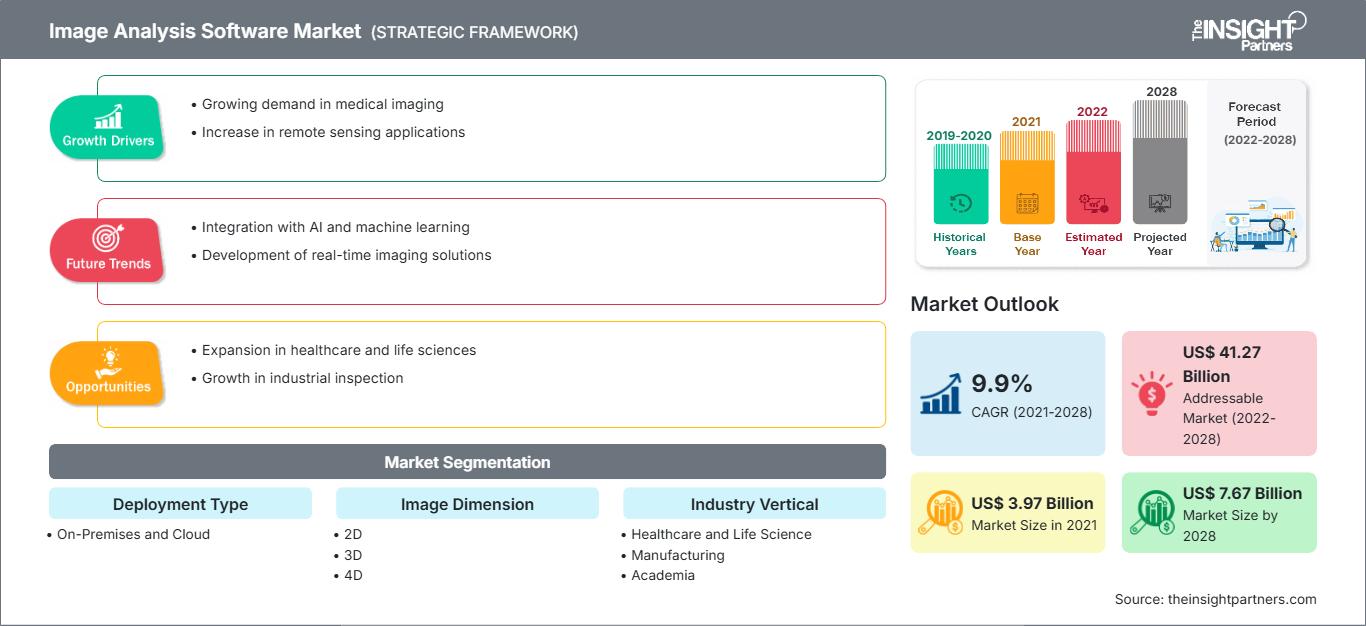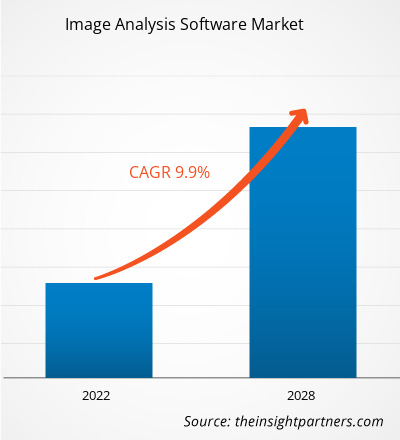[Forschungsbericht]Der Markt für Bildanalysesoftware soll von 3.970,93 Millionen US-Dollar im Jahr 2021 auf 7.672,16 Millionen US-Dollar im Jahr 2028 wachsen; die durchschnittliche jährliche Wachstumsrate (CAGR) von 9,9 % wird für den Zeitraum von 2021 bis 2028 geschätzt.
Der Markt für Bildanalysesoftware, oft auch als Markt für Bildanalyse bezeichnet, unterstützt die Extraktion wertvoller Daten aus Bildern, meist digitalen Bildern, mithilfe digitaler Bildverarbeitungstechniken. Die Aufgaben der Bildanalyse reichen vom einfachen Scannen von Barcodes bis hin zur komplexen Gesichtserkennung. Computer werden benötigt, um riesige Datenmengen zu verarbeiten, komplexe Berechnungen durchzuführen und quantitative Daten zu extrahieren. Wenn ein Computer oder ein elektrisches Gerät ein Bild analysiert, um verwertbare Informationen zu extrahieren, spricht man von digitaler Bildanalyse oder Computerbildanalyse. Es integriert Mustererkennung, digitale Geometrie und Signalverarbeitung in die Bereiche Computer- bzw. Maschinensicht und medizinische Bildgebung. Bildanalyse-Softwareanwendungen auf Basis von Künstlicher Intelligenz (KI) und Maschinellem Lernen (ML) definieren die Automobilindustrie neu. Sie werden bereits in der Automobilindustrie in Design, Lieferkette, Produktion und Nachbearbeitung eingesetzt. Darüber hinaus werden KI und Maschinelles Lernen in Fahrassistenz- und Fahrerrisikobewertungssystemen eingesetzt und revolutionieren die Transportbranche. Künstliche Intelligenz verändert auch verschiedene Aftermarket-Dienstleistungen wie vorausschauende Wartung und Versicherung. In der Automobilindustrie hat Maschinelles Lernen zur Entwicklung neuer intelligenter Produkte und verbesserter Arbeitsmethoden geführt.
Formen finden, Kanten erkennen, Rauschen reduzieren, Objekte zählen und Statistiken für Texturanalyse oder Bildqualität erstellen sind Beispiele für Bildanalyseaufgaben. Es handelt sich um die quantitative oder qualitative Charakterisierung digitaler Bilder in zwei (2D) oder drei (3D), wobei Computer Vision 2D-Bilder analysiert, während die medizinische Bildgebung 3D-Bilder analysiert. Bildanalysesoftware wird häufig in der Mikroskopie und zur Untersuchung wissenschaftlicher Bilder eingesetzt. Das Wachstum des Marktes für Bildanalysesoftware wird hauptsächlich durch die breite Akzeptanz der Software im Gesundheitswesen und in der Biowissenschaftsbranche vorangetrieben.
Passen Sie diesen Bericht Ihren Anforderungen an
Sie erhalten kostenlos Anpassungen an jedem Bericht, einschließlich Teilen dieses Berichts oder einer Analyse auf Länderebene, eines Excel-Datenpakets sowie tolle Angebote und Rabatte für Start-ups und Universitäten.
Markt für Bildanalysesoftware: Strategische Einblicke

-
Holen Sie sich die wichtigsten Markttrends aus diesem Bericht.Dieses KOSTENLOSE Beispiel umfasst Datenanalysen, die von Markttrends bis hin zu Schätzungen und Prognosen reichen.
Auswirkungen der COVID-19-Pandemie auf den Markt für Bildanalysesoftware
Die COVID-19-Pandemie hat dem Markt für Bildanalysesoftware zugutegekommen. Unternehmen stehen aufgrund der COVID-19-Pandemie und der Entwicklung von Remote-Arbeitsumgebungen vor neuen Herausforderungen. Der COVID-19-Ausbruch hat die Notwendigkeit für Unternehmen verschiedener Branchen verdeutlicht, digitale Technologien einzuführen und das Potenzial von Lösungen und Dienstleistungen des Marktes für Bildanalysesoftware zu nutzen, um Betriebsabläufe und Kosten zu optimieren, was den ROI von IT-Tools weiter steigern wird. Darüber hinaus brachte der Ausbruch der Pandemie im Jahr 2020 eine Reihe von Herausforderungen für den globalen Markt für Bildanalysesoftware mit sich. Die Gesundheitsinfrastruktur in den entwickelten Volkswirtschaften ist aufgrund der steigenden COVID-19-Fälle zusammengebrochen. Daher erfordert der öffentliche Gesundheitsnotstand ein Eingreifen von Regierung und Marktteilnehmern und die Unterstützung der Wiederbelebung des Marktes für Bildanalysesoftware und der damit verbundenen Umsätze durch gemeinsame Forschungs- und Entwicklungsinitiativen, um die Verluste im Prognosezeitraum auszugleichen. Zudem verheißen die gestiegenen Investitionen Gutes für den Markt für Bildanalysesoftware in den kommenden Jahren.
Markteinblick in Bildanalysesoftware: Wachsende Nachfrage nach Sicherheitsanwendungen und -produkten mit Bildanalyse
Unternehmen haben begonnen, das Potenzial zu erkennen, das in der Erschließung von Ressourcen aus unstrukturierten Daten liegt. Sie können Fotos oder Videos verwenden, um im Einzelhandel, in der Unterhaltungsbranche, bei Versicherungsansprüchen und in anderen Branchen ein einzigartiges und ansprechendes Kundenerlebnis zu schaffen. Bildanalyse wird zur Unterstützung einer wachsenden Zahl von Anwendungsfällen in Unternehmen eingesetzt. Diese praktischen Anwendungen von Deep Learning und Bildanalyse sind das Ergebnis von Fortschritten bei Algorithmen des maschinellen Lernens, der Verfügbarkeit von Datensätzen und der Existenz robuster Technologien mit Plattformen, die eine Echtzeitverarbeitung ermöglichen. Viele Flughäfen in den Vereinigten Staaten rüsten ihre Ausrüstung auf, um biometrische Daten wie Finger- oder Iris-Scans als alternative Sicherheitskontrolltechnik zu ermöglichen. Unternehmen erwarten eine deutliche Kapazitätssteigerung durch den Einsatz von Bildanalysetechnologie für den Transfer von Passagieren von der Ankunft über die Sicherheitskontrolle zum Abfluggate.
Markt für Bildanalysesoftware – Segmenteinblicke nach Bereitstellungsart
Basierend auf der Bereitstellung ist der Markt für Bildanalysesoftware in On-Premises und Cloud unterteilt. On-Premises-Software wird auf Computern in den Räumlichkeiten des Benutzers oder Unternehmens installiert und betrieben und nicht an einem entfernten Standort wie einer Serverfarm oder in der Cloud. Da On-Premises-Software mehr Flexibilität, Stabilität und Sicherheit bietet, verkaufen mittlerweile mehrere Marktteilnehmer On-Premises-Software. Beispielsweise sind die visuellen KI-Lösungen von On-Premises Imagga für die vollständige Bereitstellung auf den privaten, lokalen Servern eines Unternehmens verfügbar. Datensensible Organisationen können die preisgekrönte visuelle KI-Technologie von Imagga nutzen, um Auto-Tagging, Auto-Kategorisierung, Farbextraktion, benutzerdefiniertes Training und Gesichtserkennung durchzuführen und dabei Datenschutzgesetze und -vorschriften vollständig einzuhalten.
Markt für Bildanalysesoftware – Einblicke in das Segment Bilddimension
Basierend auf der Bilddimension ist der Markt für Bildanalysesoftware in 2D, 3D und 4D segmentiert. 2D-Bilder werden mithilfe der x- und y-Achse erstellt. Traditionell wurden 2D-Bilder als Quelle für Animationen und Videos verwendet. Es handelt sich um eine ältere Technologie mit einer langen Geschichte, die jedoch aus gutem Grund immer noch ein Klassiker ist. Diese Bilder sind einfach, optisch ansprechend und leicht zu konsumieren, ohne die Kunden zu überfordern oder zu verstören. 2D-Bilder sind in Animationen und Videospielen weit verbreitet, da sie eine realistische und dennoch flache Perspektive der Bewegung auf dem Bildschirm bieten. Daher bieten mehrere Unternehmen der Branche jetzt Software zur Analyse von 2D-Fotos an. Die 2D-Bildanalysesoftware Image-Pro Plus von Media Cybernetics, Inc. hilft beispielsweise dabei, Fotos zu sammeln, Objekte zu zählen, zu messen und zu klassifizieren und den Prozess zu automatisieren. Mikroskopsteuerung, Bilderfassung, Messung, Zählung/Größe und Makroentwicklung sind in diesem Softwarepaket enthalten.
Markt für Bildanalysesoftware – Einblicke in die verschiedenen Branchen
Basierend auf den Branchen ist der Markt für Bildanalysesoftware in die Bereiche Gesundheitswesen und Biowissenschaften, Fertigung, Wissenschaft, Mineralien, Metalle und Öl und weitere unterteilt. In der Medizinbranche ist Bildanalysesoftware in verschiedenen Bereichen nützlich, beispielsweise in der Neurologie, Kardiologie, Orthopädie, Zahnmedizin und Onkologie. Die Software kann Bilder lesen, die durch Röntgen, MRT, CT, PET und Ultraschall erstellt wurden. Dadurch können Prozesse automatisiert und beschleunigt werden, um manuelle Arbeit zu vermeiden und Zeit zu sparen. Die Software kann lernen, bestimmte Merkmale in diesen Fotos zu erkennen, wodurch die Diagnose schnell und genau wird. Medizinische Bildverarbeitungssoftware bietet zahlreiche Funktionen. KI-basierte Lösungen erkennen Unregelmäßigkeiten und potenziell gefährliche Anomalien und zeigen auch an, ob der Patient an Krebs oder einem gutartigen Tumor leidet. Die Software kann neben normalen 2D-Bildern (die zeitliche Veränderungen darstellen) auch 3D- und sogenannte 4D-Fotos lesen.
Markt für Bildanalysesoftware
Die Akteure auf dem Markt für Bildanalysesoftware konzentrieren sich auf neue Produktinnovationen und -entwicklungen, indem sie fortschrittliche Technologien und Funktionen integrieren, um wettbewerbsfähig zu bleiben. Im Oktober 2021 veröffentlichte Clemex Vision einzigartige Anweisungen für martensitische, ferritische und austenitische Körner sowie ML-Funktionen. Diese neuen automatischen Methoden wurden in die Toolbox der bestehenden Software aufgenommen, um eine schnelle und genaue Technik zur visuellen Identifizierung schwieriger Mikrostrukturen bereitzustellen.
Basierend auf dem Bereitstellungstyp ist der Markt für Bildanalysesoftware in On-Premises und Cloud unterteilt. Basierend auf der Bilddimension ist der Markt für Bildanalysesoftware in 2D, 3D und 4D segmentiert. Der Markt für Bildanalysesoftware ist branchenspezifisch in die Bereiche Gesundheitswesen und Biowissenschaften, Fertigung, Wissenschaft, Mineralien, Metalle und Öl sowie weitere unterteilt. Regional unterteilt sich der globale Markt für Bildanalysesoftware in Nordamerika, Europa, Asien-Pazifik, Naher Osten und Afrika sowie Südamerika.
Bildanalysesoftware
Regionale Einblicke in den Markt für BildanalysesoftwareDie Analysten von The Insight Partners haben die regionalen Trends und Faktoren, die den Markt für Bildanalysesoftware im Prognosezeitraum beeinflussen, ausführlich erläutert. In diesem Abschnitt werden auch die Marktsegmente und die geografische Lage in Nordamerika, Europa, dem asiatisch-pazifischen Raum, dem Nahen Osten und Afrika sowie Süd- und Mittelamerika erörtert.
Umfang des Marktberichts zur Bildanalysesoftware
| Berichtsattribut | Einzelheiten |
|---|---|
| Marktgröße in 2021 | US$ 3.97 Billion |
| Marktgröße nach 2028 | US$ 7.67 Billion |
| Globale CAGR (2021 - 2028) | 9.9% |
| Historische Daten | 2019-2020 |
| Prognosezeitraum | 2022-2028 |
| Abgedeckte Segmente |
By Bereitstellungstyp
|
| Abgedeckte Regionen und Länder |
Nordamerika
|
| Marktführer und wichtige Unternehmensprofile |
|
Dichte der Marktteilnehmer für Bildanalysesoftware: Verständnis ihrer Auswirkungen auf die Geschäftsdynamik
Der Markt für Bildanalysesoftware wächst rasant. Dies ist auf die steigende Nachfrage der Endnutzer zurückzuführen, die auf Faktoren wie veränderte Verbraucherpräferenzen, technologische Fortschritte und ein stärkeres Bewusstsein für die Produktvorteile zurückzuführen ist. Mit der steigenden Nachfrage erweitern Unternehmen ihr Angebot, entwickeln Innovationen, um den Bedürfnissen der Verbraucher gerecht zu werden, und nutzen neue Trends, was das Marktwachstum weiter ankurbelt.

- Holen Sie sich die Markt für Bildanalysesoftware Übersicht der wichtigsten Akteure
Markt für Bildanalysesoftware – Unternehmensprofile
- ADCIS SA
- Bio-Rad Laboratories, Inc.
- Oxford Instruments
- Clemex Technologies, Inc.
- Media Cybernetics, Inc.
- MIPAR Software LLC
- Olympus Corporation
- Pax-it
- PerkinElmer, Inc.
- TissueGnostics GmbH
- Leica Microsystems GmbH
- MVTec Software GmbH
- Carl Zeiss AG
- Scale AI, Inc.
- Labelbox, Inc
- V7 Ltd
- Historische Analyse (2 Jahre), Basisjahr, Prognose (7 Jahre) mit CAGR
- PEST- und SWOT-Analyse
- Marktgröße Wert/Volumen – Global, Regional, Land
- Branchen- und Wettbewerbslandschaft
- Excel-Datensatz
Aktuelle Berichte
Verwandte Berichte
Erfahrungsberichte
Grund zum Kauf
- Fundierte Entscheidungsfindung
- Marktdynamik verstehen
- Wettbewerbsanalyse
- Kundeneinblicke
- Marktprognosen
- Risikominimierung
- Strategische Planung
- Investitionsbegründung
- Identifizierung neuer Märkte
- Verbesserung von Marketingstrategien
- Steigerung der Betriebseffizienz
- Anpassung an regulatorische Trends






















 Kostenlose Probe anfordern für - Markt für Bildanalysesoftware
Kostenlose Probe anfordern für - Markt für Bildanalysesoftware